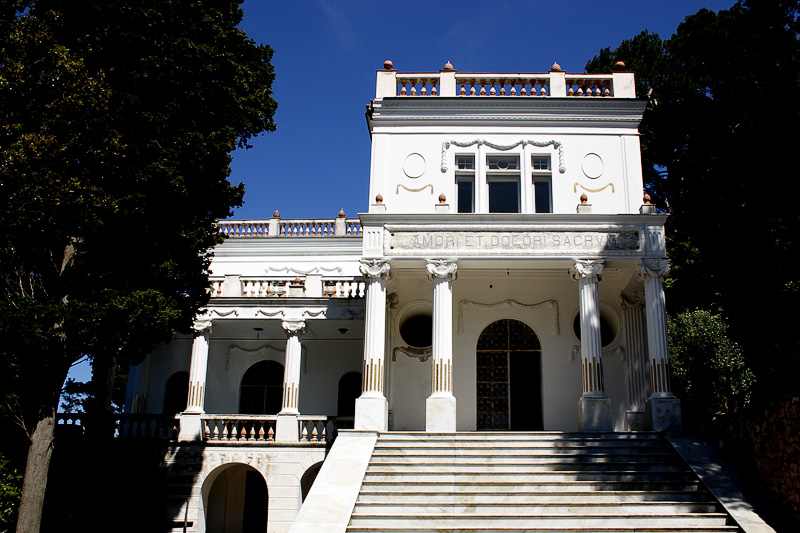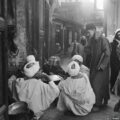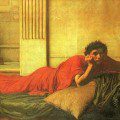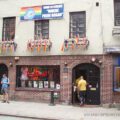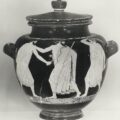Our gay history and art tour of Italy is starting in 5 days, so I’m in Italy making a few last-minute arrangements. And in the meantime, I’m doing a bit of gay history exploration–today an exploration of gay Capri. I went out to Capri mainly to look into the ruins of Emperor Tiberius’ villa. Tiberius, Augustus’ stepson and successor, has a miserable reputation. The main problem seems to be that he hated being Emperor; plus he didn’t have much charisma–and Augustus was a hard act to follow. In the end, he retired to a villa on Capri for the last ten years of his reign. Frankly, my suspicion is that like Greta Garbo, he wanted to be alone. But that is not what people said, of course. Rumor had it that he shut himself up with pornography and sex slaves of both sexes, including ones that were under-age even by Roman standards. Who knows? Maybe there was some fire behind the smoke. Anyway, I hadn’t been up to the ruins of his villa for a long time, so I wanted to check it out. Result: it is too long and steep a walk for a tour group, and frankly, it’s not a very interesting ruin, especially given the competition across the bay in Pompeii.
But that didn’t mean it was a wasted day. On the contrary. Instead of imperial perversions, what I turned up was a lot of evidence of more recent gay history on Capri. Capri was a hotspot for European gay life in the early 20th century, and luckily our forefathers left a little evidence behind. The first thing I found when I got to the village is that the town’s beautiful garden, with views of the island’s most famous rock formations, was donated, along with a fabulous switchback road connecting it to the back of the island, by Friedrich Alfred Krupp–the subject of Germany’s biggest gay scandal of the early 20th century. Krupp was of course a steel magnate, but also an important politician and a close friend of the Kaiser’s. But his life fell apart in 1902 when he was accused in opposition newspapers of having sexual relations with various local boys on Capri. Sadly (though typically, for the era) he committed suicide.
When Krupp was first in Capri, he stayed in the elegant Hotel Quisisana, still reigning in 5 star splendor over the center of the town. I was charmed to find out that our hero Mr. Wilde also stayed at the Quisisana, with his lover Lord Alfred (“Bosie”) Douglas, in October of 1897, while the two of them were living together in Naples–the last time they lived together, before their families forced them to separate. Sadly, the stay lasted only a night, as Wilde apparently was refused service in Capri’s restaurants–typical of his treatment after prison.
A number of other gay characters lived on Capri, however, suggesting that it was on the whole a gay-tolerant place, at least for foreigners. One of these was the early photographer of male nudes, Wilhelm Pluschow (cousin of the better known Baron von Gloeden). Another was the author Norman Douglas, whose most famous novel, South Wind, is set on Capri (and whom I have always loved for his very amusing and very racy limericks).
And luckily, one villa is left that (although stripped of its furniture and sexy artworks) gives one an idea of the campy world they inhabited. This is the Villa Lysis, which is right under Tiberius’ imperial villa, but a less daunting walk from the village of Capri. The villa was built by a fascinating minor French poet (and steel millionaire) called Jacques d’Adelswärd-Fersen (a relative of the count Fersen who was rumored to be Marie-Antoinette’s lover). D’Adelswärd-Fersen, put on trial for having arranged tableaux vivants of nude or semi-nude schoolboys (!), moved to Capri and built a fantasy Roman-Moorish-art nouveau palazzo in a location with fabulous views over the Capri coastline, where he lived with his boyfriend Nino Cesarini–one of the Italian boys that Pluschow photographed. He named the villa for Plato’s dialogue Lysis, which starts with a famous scene of male-male love in Classical Athens, and, as one can see in the photo, placed the motto Amori et dolori sacrum (sacred to love and pain) over the door. Sadly, the love and pain were too much for him, and he seems like Krupp to have committed suicide–by drinking a concoction of cocaine and champagne–in 1923. But he lives on through his villa and through his many appearances in other people’s books, such as the novel L’exilé de Capri, which the gay French writer and gadfly Roger Peyrefitte wrote about him.
So you see: although our gay Italy tour will mostly focus on same-sex love in ancient Rome and the Renaissance, there’s plenty of more recent gay history in Capri as well!
For Passport Magazine’s take on Capri’s gay history, see: http://www.passportmagazine.com/departments/Capri.php

